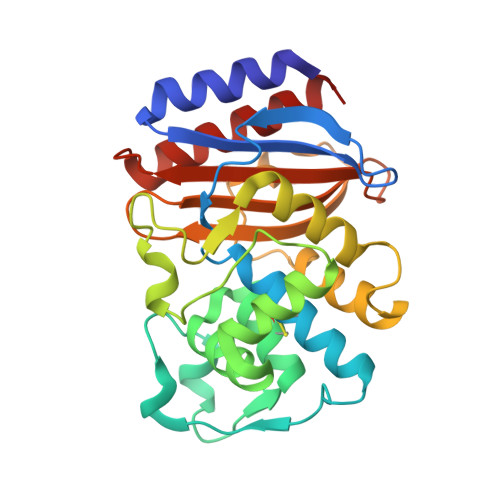The structural bases of antibiotic resistance in the clinically derived mutant beta-lactamases TEM-30, TEM-32, and TEM-34.
Wang, X., Minasov, G., Shoichet, B.K.(2002) J Biol Chem 277: 32149-32156
- PubMed: 12058046
- DOI: https://doi.org/10.1074/jbc.M204212200
- Primary Citation of Related Structures:
1LHY, 1LI0, 1LI9 - PubMed Abstract:
Widespread use of beta-lactam antibiotics has promoted the evolution of beta-lactamase mutant enzymes that can hydrolyze ever newer classes of these drugs. Among the most pernicious mutants are the inhibitor-resistant TEM beta-lactamases (IRTs), which elude mechanism-based inhibitors, such as clavulanate. Despite much research on these IRTs, little is known about the structural bases of their action. This has made it difficult to understand how many of the resistance substitutions act as they often occur far from Ser-130. Here, three IRT structures, TEM-30 (R244S), TEM-32 (M69I/M182T), and TEM-34 (M69V), are determined by x-ray crystallography at 2.00, 1.61, and 1.52 A, respectively. In TEM-30, the Arg-244 --> Ser substitution (7.8 A from Ser-130) displaces a conserved water molecule that usually interacts with the beta-lactam C3 carboxylate. In TEM-32, the substitution Met-69 --> Ile (10 A from Ser-130) appears to distort Ser-70, which in turn causes Ser-130 to adopt a new conformation, moving its O gamma further away, 2.3 A from where the inhibitor would bind. This substitution also destabilizes the enzyme by 1.3 kcal/mol. The Met-182 --> Thr substitution (20 A from Ser-130) has no effect on enzyme activity but rather restabilizes the enzyme by 2.9 kcal/mol. In TEM-34, the Met-69 --> Val substitution similarly leads to a conformational change in Ser-130, this time causing it to hydrogen bond with Lys-73 and Lys-234. This masks the lone pair electrons of Ser-130 O gamma, reducing its nucleophilicity for cross-linking. In these three structures, distant substitutions result in accommodations that converge on the same point of action, the local environment of Ser-130.
Organizational Affiliation:
Department of Molecular Pharmacology and Biological Chemistry, Northwestern University, Chicago, Illinois 60611-3008, USA.
















